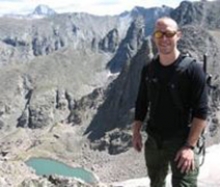
As the Rim Fire continues to burn in and around Yosemite National Park, a former UC Merced student’s work related to the fire burned up the Internet this week.
Paul Doherty, the first Yosemite park ranger to complete at doctoral degree at UC Merced, graduated in the spring and now works as a public safety technology specialist for Esri, a company that provides GIS mapping for a variety of applications.
Doherty and his team created a layered map that shows up-to-the-minute details of the fire, including its size and range, hot spots, the fire’s progression, a history of fire in the national park and more.
They pulled together data from a wide range of agencies, including Cal Fire, the U.S. Forest Service, FEMA, the Red Cross and many others to make the map that went viral this week as people watched one of California’s largest wildfires rage on. The map was also featured online at The Atlantic, Time and CNET.
“Once we had a story board of our ideas, we constructed the three web maps very quickly,” Doherty said. “Then we just needed a simple application to tie them altogether to tell the story – that is why it is called a story map.”
With his background as a Yosemite park ranger, years of experience using geographic information systems and his work in the Spatial Analysis and Remote Sensing graduate lab at UC Merced, Doherty is a natural for the Disaster Response Program at Esri.
“Our lab spent a lot of time developing plans to solve problems and use geography to better understand the answers. These were usually long-term research projects, but the brainstorming process we used there, along with the training in Spatial Analysis really prepared me for this position,” Doherty said.
He said that during his time at UC Merced, he made “so many” maps, mostly related to his coursework in Environmental Systems through the School of Engineering. His research focused on how GIS can be used for search-and-rescue operations in Yosemite, and he made maps showing where people get lost or injured and used GIS to solve problems related to finding and rescuing them.
“Of course paper maps are indispensable for a variety of reasons, but the interactive nature of these web maps really encourage the audience to explore for themselves. They encourage you to communicate with others, which is easier than ever with the pervasive use of social media,” Doherty said.
GIS has traditionally been thought of as a niche field with lots of applications for experts using specialized software. But even with more than 1 million people using the specialized desktop software, the world's challenges need a more pervasive use of geographic information. UC Merced understands this and is designing a curriculum through the Spatial Analysis and Research Center (SpARC) that offers competency and core capabilities in GIS and GIScience with cutting-edge research opportunities. This will prepare leaders in the GIS field. In addition, UC Merced will continue to leverage its excellent Computer Science program to develop advanced analysis and customized tools for GIS.
Introductory-level opportunities for a wider audience of students, faculty and the community in general, demonstrating how to quickly make maps about topics they are interested in – like the Rim Fire – will promote greater geographic understanding.
Doherty said maps about ecosystems, agriculture, anthropology, crime prevention, health, marketing and retail and other areas will have a lasting effect on the campus, the community, the state and all of the places where UC Merced researchers work.
“You should expect to see a lot of web maps in the near future,” he said.



